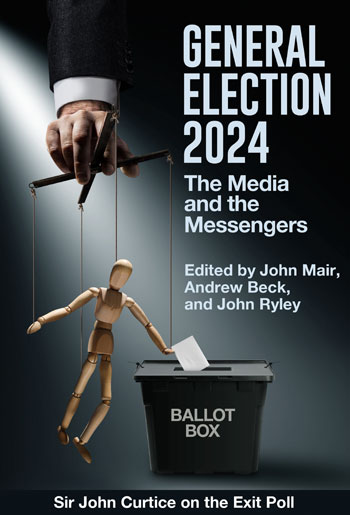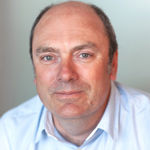
My first job in journalism was working for a very well regarded local weekly newspaper, the Stockport Express in 1987. Within weeks of me joining the paper, Margaret Thatcher began the general election campaign which was to result in her third term in office. For someone interested in covering politics, the campaign was a real baptism of fire as the Express was at the heart of the election coverage locally. I was thrown straight into the fray, interviewing Labour challengers, local campaigners, and a Tory minister on their battle bus, as well as being part of a team covering election night.
Nearly 40 years and nine elections later, the way the campaigns are covered is very different. A technological revolution has resulted in the closure of hundreds of newspaper print titles and a reconfiguration of local news with far fewer journalists covering broader patches. Today, although the Stockport Express still exists as a printed product, it is a shadow of its former self, produced on the outskirts of Oldham, the base of the area’s regional parent title — the Manchester Evening News (MEN). It will be down to the MEN’s reporting staff to cover every Greater Manchester constituency in this year’s election and although the regional title is very good at what it does — covering the big regional stories, the manifesto pledges and policies — there can be no doubt that industry changes have had an impact on the localness of election coverage, with a consequent impact on local communities and democracy.
The rise of the hyperlocal
Attempting to fill the gap left by the withdrawal of legacy media from communities across the country is a new breed of news outlets, commonly referred to as hyperlocal or independent community media. These titles, ranging from very local not-for-profit sites to commercial outfits, are attempting to make their mark in the industry championed by the Public Interest News Foundation and represented by the Independent Community News Network, a body with currently 118 members. We have also seen the emergence of the Nub network, which has attempted to replicate online the role local weekly newspapers played. One of Nub’s outlets covers Stockport. Could this hyperlocal network fill the local gaps in election coverage left by the increasing regionalisation of news?
As someone who tried to fill some of those gaps in my local area, Wythenshawe in Manchester, running a not-for-profit site in a deprived area, the Wythenshawe Reporter, I am interested in how successful the hyperlocals can be in delivering one of the most critical information needs in areas of deprivation — useful insights about candidates standing in local elections and their policies.
The hyperlocal sector has been seen as an exciting feature in the development of the news ecosystem, ushering in a new wave of digital titles which are independent and focused on local communities — some powered by local advertising and others functioning on a not-for-profit basis. Questions exist as to whether these outlets can fill these gaps in all communities and whether social deprivation makes a difference when assessing the extent to which those hyperlocals can make that contribution. In areas where there is market failure as far as advertising is concerned, it may be that there is an argument for public subsidy to ensure public interest journalism can be maintained by those hyperlocal sites which face a precarious existence compared with sites in more affluent areas which can be supported by advertising.
The study
To explore these issues, I embarked on a longitudinal study examining the media coverage of four UK general elections — 2010, 2015, 2017, and 2019 — focusing on two of the most deprived and two of the least deprived constituencies in the country as part of research for my PhD. The study examined the changing nature of coverage, exploring how the quantity (that is, the volume of stories) and quality (that is, the depth of focus on constituencies and candidates) of election coverage had changed. New emerging hyperlocal news sites made up for a decline in coverage in the least deprived constituencies but the more deprived communities appear to be losing out, raising questions about whether the hyperlocal sector requires public money to ensure the fulfilment of critical information needs.
The areas chosen for my study were Wythenshawe and Sale East, Blackley and Broughton, Altrincham and Sale West, and Tatton. A content analysis of the coverage of each constituency was carried out to explore the hypothesis that there is a link between deprivation and the quantity and quality of media coverage. An analysis of print coverage of the 25 days preceding the election was carried out — counting the number of stories, their platform, word count, and prominence in the publications. The content of the stories was also coded into three categories according to whether they (1) focused on the constituency, (2) quoted the incumbent candidate from the constituency, or (3) quoted candidates including those other than the incumbent — thus providing an analysis of the quality of the coverage and the extent to which the electorates were presented with a diversity of political views. The research also looked for evidence as to whether independent online community (hyperlocal) sites were filling a gap in the provision of election stories relating to local communities left by what has been perceived to be a decline in local legacy media.
The first trend that can be observed is that there was a significant increase in words written about both the most and least deprived constituencies between the 2010 and 2015 elections. The combined increase was an 83 per cent rise. As the digital-first trend developed between 2010 and 2015, it would be expected that a rise in online stories on legacy news sites would occur and indeed this was the case. In the least deprived constituencies, the word count for election stories in print dropped considerably from 11,169 to 4,013, which can be explained by the demise of the Wilmslow Express which closed shortly before the 2015 election. It had produced 6,509 words in 2010. This drop in print word count was more than made up for by the contribution made by independent community news sites which became part of the news ecology in 2015. They contributed 11,657 words on the election.
It was a different story in the more deprived constituencies — the word count for print stories there continued a downward trend over the next two elections whilst online content carried by legacy media dipped in 2017, rising in 2019 but not reaching the heights of the 2015 election. In the least deprived constituencies, a local legacy title, the Knutsford Guardian played a significant part in contributing coverage in both 2017 and 2019 in print and online. However, it was independent online sites which provided the bulk of the coverage, particularly in 2019.
The findings of the study suggest that newspaper cuts and closures affect all communities and that hyperlocal sites can fill a gap in news provision, but the gap has not been filled adequately in deprived areas, and this may result in a democratic deficit. The findings raise questions of whether there is a digital consumption and access gap based on class, exacerbated by a digital production gap, in so far as, according to a Westminster Media Forum Seminar in 2015, most hyperlocals are run by “white, middle-class men”. And even white professionals like me are forced to confront the realities of trying to run a news site which stands little chance of raising the revenue needed to be sustainable in an area of deprivation like Wythenshawe. My own site was essentially subsidised by my salary as a journalism lecturer, but working full-time meant that the time needed to produce the site was in short supply. Consequently, the Wythenshawe Reporter was put on hiatus and unfortunately will not be contributing to election coverage this year.
If healthy media ecosystems are to be maintained in deprived areas, this study suggests commercial sources of funding are not adequate and that public money and other sources of support are required to fund hyperlocal sites to return to the levels and quality of coverage enjoyed by communities when I began my career in journalism.

This chapter is taken from the new book, “General Election 2024: The Media and the Messengers”, edited by John Mair, Andrew Beck and John Ryley and published in June. Available to purchase here.
This article was first published in InPublishing magazine. If you would like to be added to the free mailing list to receive the magazine, please register here.












